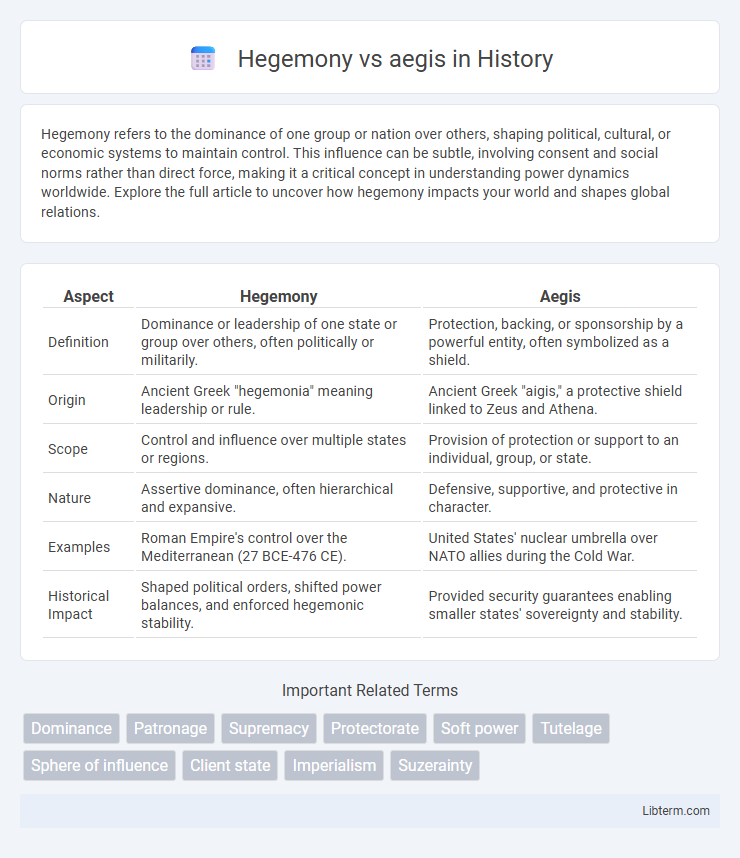Hegemony refers to the dominance of one group or nation over others, shaping political, cultural, or economic systems to maintain control. This influence can be subtle, involving consent and social norms rather than direct force, making it a critical concept in understanding power dynamics worldwide. Explore the full article to uncover how hegemony impacts your world and shapes global relations.
Table of Comparison
| Aspect | Hegemony | Aegis |
|---|---|---|
| Definition | Dominance or leadership of one state or group over others, often politically or militarily. | Protection, backing, or sponsorship by a powerful entity, often symbolized as a shield. |
| Origin | Ancient Greek "hegemonia" meaning leadership or rule. | Ancient Greek "aigis," a protective shield linked to Zeus and Athena. |
| Scope | Control and influence over multiple states or regions. | Provision of protection or support to an individual, group, or state. |
| Nature | Assertive dominance, often hierarchical and expansive. | Defensive, supportive, and protective in character. |
| Examples | Roman Empire's control over the Mediterranean (27 BCE-476 CE). | United States' nuclear umbrella over NATO allies during the Cold War. |
| Historical Impact | Shaped political orders, shifted power balances, and enforced hegemonic stability. | Provided security guarantees enabling smaller states' sovereignty and stability. |
Understanding Hegemony: Definition and Origins
Hegemony refers to the dominant influence or leadership one state or group exercises over others, rooted in cultural, economic, and political power rather than mere force. The concept originates from ancient Greek political theory and was later expanded by Antonio Gramsci, who emphasized ideological leadership and consent in maintaining social dominance. Understanding hegemony involves recognizing how power structures shape societal norms and international relations through both coercion and consensus.
The Concept of Aegis: Historical Context
The concept of aegis originates from ancient Greek mythology, where it symbolized the protective shield or breastplate associated with Zeus and Athena, representing divine authority and protection. Historically, aegis evolved into a metaphor for a protective power or sponsorship exercised by a dominant entity, often invoked in political and military contexts to signify the guarding influence of a powerful state or leader. This contrasts with hegemony, which implies not only protection but also dominance and control over subordinate states within a hierarchical power structure.
Key Differences Between Hegemony and Aegis
Hegemony refers to dominant influence or leadership exercised by one state or group over others, often through political, economic, or military means, whereas aegis signifies protection, sponsorship, or guidance provided by a powerful entity. Key differences lie in hegemony's emphasis on control and authority, while aegis highlights support and safeguarding. Hegemony implies dominance in a competitive or hierarchical context, contrasting with aegis, which implies guardianship without overt control.
Hegemony in International Relations
Hegemony in international relations refers to the dominance of one state or group over others, shaping global political, economic, and military structures. This supremacy allows the hegemon to enforce rules, influence alliances, and maintain order within the international system. Unlike aegis, which implies protection or sponsorship, hegemony encompasses comprehensive control and leadership across multiple domains.
The Role of Aegis in Global Politics
Aegis in global politics represents protective influence or dominance exerted by a powerful state to maintain stability and security within a region, often under the guise of safeguarding allies and international norms. Unlike hegemony, which implies outright control or leadership, aegis emphasizes a guardian role, ensuring order through strategic alliances, military presence, and diplomatic support. The aegis framework shapes international relations by balancing power without direct governance, enabling states to project influence while respecting sovereignty.
Power Dynamics: Direct Control vs Protective Influence
Hegemony implies direct control and dominance over others, exerting power through political, economic, or military means to shape behaviors and decisions. Aegis represents protective influence, where power is exercised by safeguarding and supporting allies without overt domination, fostering stability through consent rather than coercion. The distinction lies in hegemony's authoritative command contrasted with aegis's role in providing security and legitimacy within power dynamics.
Case Studies: Examples of Hegemony and Aegis
The U.S. dominance in global politics exemplifies hegemony, where unilateral influence shapes international norms and economic policies, as seen in post-Cold War interventions and trade regulations. In contrast, NATO under the aegis of collective defense operates through multilateral agreement and shared security responsibilities, highlighting protection rather than domination. South Korea's alliance with the U.S. demonstrates aegis by relying on American military support to deter aggression without exerting control over its sovereignty.
Implications for Modern Geopolitics
Hegemony in modern geopolitics implies dominance by a single state or coalition exerting influence through economic, military, or cultural power, often leading to unilateral decision-making and global strategic control. Aegis, in contrast, refers to protective alliances or frameworks, such as NATO's collective defense principle, emphasizing shared security and multilateral cooperation. Understanding these dynamics shapes how global powers navigate conflict, diplomacy, and influence, impacting international stability and the balance of power.
Challenges and Criticisms of Hegemonic Power
Hegemonic power faces challenges such as resistance from subordinate states seeking autonomy and the difficulty of sustaining dominance amid shifting global dynamics. Critics argue hegemonies often impose unequal economic and political burdens, provoking unrest and undermining international cooperation. The reliance on coercion and unilateral decision-making further erodes legitimacy and invites counterbalancing coalitions.
The Future of Power Structures: Hegemony or Aegis?
The future of power structures hinges on whether global influence will continue through hegemony or evolve towards aegis, emphasizing protective leadership over dominance. Hegemony prioritizes control and unilateral decision-making, while aegis fosters collaboration, mutual security, and shared responsibilities among nations. Emerging geopolitical trends suggest a shift towards aegis, where power is exercised through alliances and support systems rather than coercive supremacy.
Hegemony Infographic

 libterm.com
libterm.com